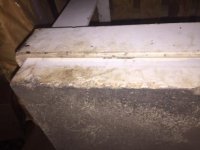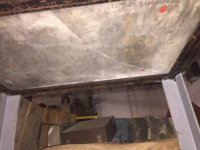Some would jump to the conclusion that this is a mounted surface plate, but almost everything is wrong for a mounted surface plate. The stone measures 36x24x4.5”. Table top height is about 42”. Total table weight is about 760 lbs. Stone’s original color is bone white. The stone’s mounting is very tight on four sides and on the outer 4” of bottom surface. The tight grip of the table on the stone is all wrong for a surface plate. So was this for some kind of hot work or what?
How to install the app on iOS
Follow along with the video below to see how to install our site as a web app on your home screen.
Note: This feature may not be available in some browsers.
You are using an out of date browser. It may not display this or other websites correctly.
You should upgrade or use an alternative browser.
You should upgrade or use an alternative browser.
Purpose of stone-top table?
- Thread starter Cannonmn
- Start date
- Replies 17
- Views 3,544
wheels17
Stainless
- Joined
- May 10, 2012
- Location
- Pittsford, NY
Stone tables are often used for candy making. It sounds about the right size.
Mebfab
Diamond
- Joined
- Jun 7, 2003
- Location
- Mebane North Carolina USA
I was going to say taffee
L Vanice
Diamond
- Joined
- Feb 8, 2006
- Location
- Fort Wayne, IN
I have seen such things in candy shops that make fudge in small batches out where the customers can watch. I think dipped chocolates are also placed on a stone after dipping.
Are Marble and Granite Slabs for Baking and Candy Making a Necessity?
I have also seen a similar table in Cold Stone Creamery ice cream shops, except they refrigerated the stone to make it "cold."
Larry.
Are Marble and Granite Slabs for Baking and Candy Making a Necessity?
I have also seen a similar table in Cold Stone Creamery ice cream shops, except they refrigerated the stone to make it "cold."
Larry.
Rob F.
Diamond
- Joined
- Aug 5, 2012
- Location
- California, Central Coast
My first thought was also candy making but I dont like the stand for that. The angle frame would catch all sorts of stuff beteen it and the stone, no kitchen would have that, it would be full of mold and goo in no time.
How smooth is it? "Honed" like a surface plate, high polish like a countertop or rough like a sidewalk? If you are guessing hot work I would think it to be a rougher surface instead of polished.
Labratory counters were often made of soapstone due to its density- nothing could get into it and it also does a great job with heat. How soft is it?
How smooth is it? "Honed" like a surface plate, high polish like a countertop or rough like a sidewalk? If you are guessing hot work I would think it to be a rougher surface instead of polished.
Labratory counters were often made of soapstone due to its density- nothing could get into it and it also does a great job with heat. How soft is it?
They also used stone topped tables in the printing industry when the letterpress method was still going strong. The printer would use the flat surface to ready type forms for printing.
They were superseded by steel in no time flat, but those tables were still called "stones", also.
Not sure that this one would have been large enough, but just throwing out the possibility.
They were superseded by steel in no time flat, but those tables were still called "stones", also.
Not sure that this one would have been large enough, but just throwing out the possibility.
Pix of stone surface incl one of underside. Underside shows two pieces joined along a curve, but top is one piece, probably meaning there are two separate layers of this white stone. It isn’t soapstone. Top surface is about like sidewalk concrete. It is filled in with some black substance except where it appears “worn.”
Attachments
Last edited:
DMF_TomB
Diamond
- Joined
- Dec 13, 2008
- Location
- Rochester, NY, USA
some just like stone tables. sometimes there is no reason other than they like stone
When I was working in laboratories, we would have the fine balances which measured 0.0001g mounted on heavy stone topped tables to minimize vibration.
I’m thinking the curved joint in the bottom stone layer may provide a clue. If you have to piece almost any material together, the easiest way is to use a straight-line cut. Making a perfect curved cut in two pieces, as shown in the pic of the underside, is more difficult, and the maker must have had a reason for doing that, in addition to special equipment.
metalmagpie
Titanium
- Joined
- May 22, 2006
- Location
- Seattle
Lots of pastry is rolled out on stone. Croissants, for example.
I’ve run across an ad for a wood and stone lithography table. Ad says top is marble but I heard an antiques expert say limestone was used for lithography tables. Dunno. The balance platform makes sense too.
Lithograph Table – C & M Antiques
Lithograph Table – C & M Antiques
eKretz
Diamond; Mod Squad
- Joined
- Mar 27, 2005
- Location
- Northwest Indiana, USA
I’m thinking the curved joint in the bottom stone layer may provide a clue. If you have to piece almost any material together, the easiest way is to use a straight-line cut. Making a perfect curved cut in two pieces, as shown in the pic of the underside, is more difficult, and the maker must have had a reason for doing that, in addition to special equipment.
I think you're reading way too much into that. It's almost certainly an inclusion formed in the stone naturally, whether that be a crack or just a line of dissimilar material where something prevented the particles that make up the stone from fusing fully together at that point. I have plenty of natural stone sharpening stones with these types of inclusion that don't go all the way through the stone. They are still rigid and in one piece, but there is a definite layer line through the stone.
Last edited:
L Vanice
Diamond
- Joined
- Feb 8, 2006
- Location
- Fort Wayne, IN
I’ve run across an ad for a wood and stone lithography table. Ad says top is marble but I heard an antiques expert say limestone was used for lithography tables. Dunno. The balance platform makes sense too.
Lithograph Table – C & M Antiques
Just tonight, PBS Antiques Roadshow featured a possibly Hamilton lithography table with a smooth limestone top supported by a very sturdy oak frame with one drawer. Different shape/size than the C & M Antiques table, but looks like the same design/maker. Owner said she paid $500 in a New York City store and appraiser said it was worth more. Owner said it took six big men to move it. She had it in her living room.
Anyway, the welded steel table in the first post is nothing like the wood Hamilton tables. I could not tell how smooth the top of the lithography table was.
Larry
UncleFrank
Cast Iron
- Joined
- Nov 14, 2015
- Location
- Midwest, USA
Some fiberglass or etc layups done on stone tables. First thing down is a coat of paste wax so the layup doesn't stick to the surface.
Similar threads
- Replies
- 6
- Views
- 774
- Replies
- 9
- Views
- 979
- Replies
- 15
- Views
- 1K









